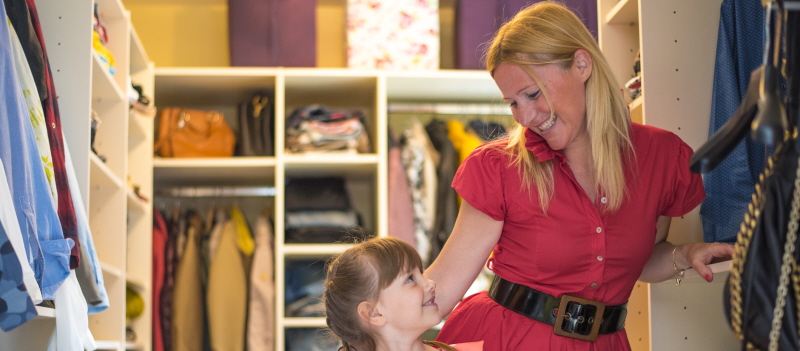closetplace
Closet Door Ideas
#

Closet Door Ideas
by Bill Huntley
Imagine you need something in your walk-in closet. The door swings into the closet and what you need is on the wall behind the door, so now you have to close yourself into this small room to get the door out of the way so you can reach what you want. Feel cramped?
Or, you're wrestling with the bifold doors on your reach-in closet and when you finally get them open the darn things are in the way and you can hardly see into the corner, let alone reach around them to get what you need. You'd like to squash the door flat into the jamb to get it out of your way--which is probably the reason it doesn't work so smoothly anymore!
Sound familiar.
The wrong door can make even the best organized closet difficult to use. The key to choosing the right door is to consider how the style and swing of the door impacts your access to the clothing in your closet. The door style is often chosen by the builder who may not be thinking about the details of your closet system in the rush to complete a new home. If you are building or remodeling, think carefully about your closet doors in the planning stages. And if you are stuck with a less than ideal closet door, it's not hard to install a new door. Most doors, regardless of their style fit in the same size rough opening. It may be worth the expense to eliminate a daily source of aggravation by changing your door style.
Here are some tips to think about when choosing your closet doors. You can find more about doors and closet planning in our Closet Planning Guide.
Walk-in Closets: It is important to consider the door swing in a walk-in closet. Unless the closet is fairly large, it is best to have the door swing out into the room rather than into the closet. A door that opens into a small walk-in may block access to items, requiring you to close yourself into the closet to get to your clothing on the wall behind the door. An in swinging door may also limit how much of the closet space is usable for shelves and hanging. An out-swing door may be left open allowing for free access to all shelves and may also let in some natural light.
Pocket doors are great for a walk-in. You won't have any space restricted on any walls because of door swing. The downside is that they can be a pain to adjust or repair if they don't slide properly. Don't scrimp on the hardware.
Reach-in Closets: Whether it's a closet for clothing, pantry, linens or utility, the type of door you use can have a tremendous impact on accessibility to what's inside. There are pros and cons to every door style. Choose the one that offers the best use of space and the least amount of compromise to accessibility.
- Double out-swing doors (like French doors): This is the best choice for closet accessibility provided you have the space in the room for the doors to swing. There is nothing to obstruct your view or your reach at the jambs. Another real plus is that this style of door will not have the operating issues that bifolds and sliding doors do. Hinged doors work flawlessly for years and years, and are easily repaired if a problem occurs.
- Bifold Doors: Bifolds can often solve a space problem when your closet is in a tight spot with no room for swinging doors. The downside is that they take up 8" to 10" of space at the jamb when folded open, possibly obstructing access to the inside corners of your reach in closet. Probably the most common complaint I hear about closet doors when consulting in client's homes is that their bifold closet doors are broken or difficult to operate.
- By-pass Sliding Doors: Like bifolds, sliders solve a space problem when there's no room to swing a door. The disadvantage is that you can only access one half of your closet at one time. Then you need to slide both doors out of the way to access the other half. Somewhat of a chore. This can be a challenge when designing closet components. You try to group similar items on each side of the divide, like clothing on one side and shoes and accessory items on the other. Sliding doors are also prone to problems like coming off the track or binding so they are hard to slide. Proper installation is the key to fewer operational problems.
When bringing design elements together in a building or remodeling project things often don't mesh the way we like. Compromise is always a part of a project. The trick is to thoughtfully evaluate all of the possibilities and then to choose the best option available.